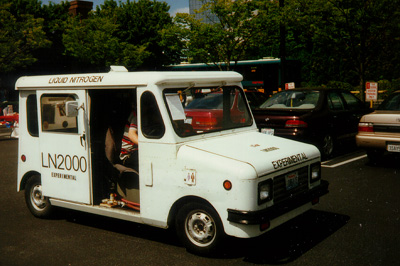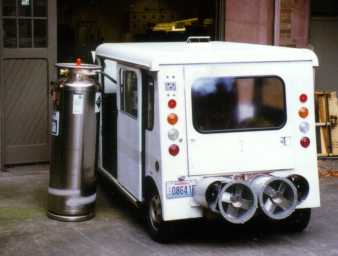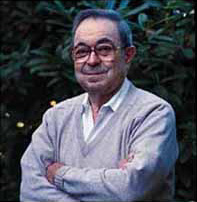Abe Hertzberg wants to pull the plug on electric cars. The retired UW professor of aeronautics and astronautics rolls his eyes at the hype propelling these supposed vehicles of the future because, he says, they have just as many safety and environmental problems as gasoline-powered cars with a fraction of the performance.
Hoping to stall the electric car bandwagon, Hertzberg and his colleagues set out to create a better alternative to grandma’s gas-guzzling Gremlin. Inspired by a Li’l Abner cartoon depicting a car that runs on smog, the UW researchers invented a liquid nitrogen vehicle which generates no harmful emissions. As a bonus, manufacturing the liquid nitrogen removes pollutants from the air.
“If you’re going to talk about a truly non-polluting car, you have to do something different than gas or electric,” explains Hertzberg. “We believe a liquid nitrogen vehicle can match the performance and range of an electric car, while still being affordable and easy to maintain and operate. And ecologically, it’s a dream come true.”
The UW vehicle—dubbed LN2000—works sort of like a steam engine, except it is powered by vaporizing very cold liquid nitrogen instead of steam from boiling water. The nitrogen vapor turns an air motor to propel the car and then exits the tailpipe. Since the atmosphere already is 78 percent nitrogen, the environmental effect of driving LN2000 vehicles—even millions of them—would be virtually undetectable, Hertzberg says.
What really excites this veteran researcher, however, is the potential of liquid nitrogen production to actually reduce air pollution. To make liquid nitrogen, Hertzberg explains, a plant would simply run air through a large refrigeration system and collect the liquid nitrogen as it condenses. In the process, pollutants such as carbon dioxide and sulfur dioxide also are removed from the air and could be disposed of in a benign manner. One option is to pump the pollutants into depleted oil and gas wells or into the deep ocean where they are unlikely to spread back into the atmosphere and cause environmental havoc.

The outside of the LN2000 liquid nitrogen-powered vehicle is the body of an old Grumman Kubvan mail truck.
Fossil fuels would mostly likely be burned to power the refrigeration plant. But the exhaust from these plants would be trapped for use as the feedstock for the liquid nitrogen, so no pollutants would be released into the atmosphere.
“We are not trying to promise an environmental free lunch,” cautions Professor Adam Bruckner, who is working with Hertzberg on the LN2000 team along with Professor Tom Mattick, research scientist Carl Knowlen and graduate students Peter Vitt and Helene DeParis. “We are simply trying to point out a significant potential environmental benefit of liquid nitrogen automobile propulsion. Compared to other supposedly green automotive propulsion systems, such as electric cars, we think our approach looks pretty good.”
Hertzberg pursued the LN2000 project in part to slow down the electric car bandwagon being propelled by laws in California and elsewhere that require 10 percent of all cars sold by the year 2003 to be zero-emission vehicles. The laws are designed to reduce air pollution, which is blamed for global warming as well as some health problems. Respiratory ailments and other smog-related illnesses lead to the premature death of 1,600 people a year in Southern California alone, according to the South Coast Air Quality Management District in Los Angeles.
Under the new laws, annual sales of zero-emission vehicles are expected to surpass 200,000 in California and 500,000 nationwide by 2003. To help meet this demand, the government and the U.S. Council for Automotive Research, a consortium of America’s Big Three automakers, have formed the Partnership for a New Generation of Vehicles to spur research and development of alternative vehicle technology.
Formed in 1993, the partnership’s long-term goal is to develop vehicles that will deliver up to three times greater fuel efficiency and cost no more to own and operate than today’s midsize family sedan, such as the Chrysler Concorde, Ford Taurus or Chevrolet Lumina. This new generation of vehicles also should maintain the performance, size and utility standards of today’s vehicles and meet all mandated safety and emission requirements, the partnership’s guidelines state.
“We’re looking at a lot of different technologies and a lot of different alternative fuels, but to my knowledge nobody here has looked at liquid nitrogen,” says Chris Terry, a spokesperson for the automobile consortium. “It sounds very interesting.”
After studying alternatives ranging from flywheels to fuel cells, consortium researchers are returning to more conventional technologies such as next-generation diesel engines and hybrid electric vehicles. This is necessary, Terry says, to meet the partnership’s goal of producing concept cars by 2000 and production prototypes by 2004.
Mike Bogdanoff, technology advancement officer with the South Coast Air Quality Management District, believes that, in the long run, fuel cells hold the most promise of any zero-emission vehicle technology to match the performance and range of today’s gasoline-powered engines.
Fuel cells generate electricity directly from a chemical reaction between hydrogen and oxygen triggered by a platinum catalyst. The chemical reaction occurs at ambient temperatures with virtually zero emissions. The main by-product is water. Fuel cells also are twice as efficient as gasoline engines when using hydrogen as a fuel. Unfortunately, no infrastructure exists to distribute hydrogen for refueling. And, though the gap is narrowing, fuel cells remain seven to 10 times more costly than conventional power trains.
“We’re probably 10 years away from a fuel-cell car,” Bogdanoff says. “The technology is there. The hard part now is bringing down the cost.”
In the meantime, electric cars powered by lead-acid batteries are the only relatively affordable and readily available zero-emission vehicles on the market. Despite their reputation as the most environmentally friendly alternative to smog-belching, gasoline-powered cars, electric cars offer chronically poor performance and present pollution and safety problems of their own, UW researchers contend.
Lead-acid batteries, which are used in General Motors’ EV1 electric car, have a limited 70-mile range and run anemically, if at all, in cold weather. In fact, GM only offers the EV1 in sunny climates such as Arizona and southern California.
Use of lead-acid batteries in electric cars also threatens to increase heavy metal pollution. Batteries for a single electric car require about 1,000 pounds of lead, so the proliferation of electric cars using lead-acid batteries will greatly increase the demand for the noxious heavy metal, says Vitt, one of the graduate students on the LN2000 team. The greater the demand for lead, he adds, the greater the threat for pollution in mining, smelting, transporting, using and disposing of it.

The LN2000 fills up from liquid nitrogen from a tank outside of a UW engineering building. Scientists say the average gas station could be easily converted to liquid nitrogen delivery.
Newer nickel-metal hydride and lithium-ion batteries offer better range and performance, but they are prohibitively expensive and potentially dangerous. As the amount of stored energy increases in these batteries, Hertzberg explains, they become more unstable and likely to explode in the event of an accident.
“Obviously in developing any new product you have new environmental concerns,” counters Bogdanoff, “but these are old arguments that really aren’t being made anymore. Electric cars, no matter what kind of battery you’re using, are better than gas-powered cars.”
Hertzberg is not so sure.
“The safe batteries are an ecological mess and can’t go anywhere,” he says. “The ones that can go somewhere are incredibly expensive and quite dangerous. You’d have to work really hard to hurt yourself with a liquid nitrogen vehicle. Liquid nitrogen isn’t combustible, corrosive or toxic. It’s just cold.”
Ironically, Hertzberg says, the cold temperature is precisely what stalled previous efforts to develop a liquid nitrogen vehicle. Researchers have known for decades that pressure built up when liquid nitrogen is converted to a gas could power a car. But the UW group was the first to develop a heat exchanger system that doesn’t freeze up when exposed to the nippy liquid nitrogen.
The LN2000’s heat exchanger pulls liquid nitrogen from an insulated fuel tank through a series of aluminum tubing coils and specially designed pipes. Engine exhaust and outside air are circulated around the coils and pipes to gradually warm up the nitrogen from a minus 320 F liquid to an ambient-temperature gas.
“The heat exchanger is like the radiator of a car, but it acts in the opposite way,” explains Bruckner. “Instead of using air to cool water, it uses air to boil liquid nitrogen into nitrogen gas.”
The conversion from liquid to gas expands the volume of the nitrogen 700 times, building sufficient pressure to turn an air motor much like pressure from burning gasoline drives an internal combustion engine.
With a $360,000 U.S. Department of Energy grant, UW researchers and students have built a LN2000 prototype from a converted Grumman Kubvan mail truck. Aside from the Husky decals, the vehicle looks much like any other postal truck on the outside. But open up the back and one finds insulated tanks, piping, hoses and gauges more befitting a research laboratory than an automobile. Under the hood is a 15 horsepower air motor originally designed to power a winch for raising ship anchors. And instead of generating plumes of foul exhaust, the LN2000 emits cold nitrogen gas which freezes water vapor in the air to form small clouds behind the vehicle.
While the reliance of internal combustion engines on non-renewable fuels has prompted automotive engineers to make car motors more efficient over the years, air motors have had the luxury of remaining fabulously inefficient. As a result, the motor used in the LN2000 prototype gives gas guzzling new meaning by consuming about five gallons of nitrogen fuel per mile. Plus it musters a top speed of only 22 m.p.h. and chugs laboriously up hills.
“This motor operates at less than 20 percent of the efficiency we think is possible, which reduces power, performance and fuel economy,” explains John Williams, a former graduate student who worked on the LN2000 project for his master’s thesis. “We know we can do better.”
Hertzberg is seeking a follow-up grant to design a more efficient motor that could achieve top speeds of 60 m.p.h. and two to three miles per gallon in an optimally designed vehicle. This would enable the LN2000, using a 100-gallon tank, to match the average range for gas-powered vehicles of 250 miles between fill-ups. As large as the 100-gallon tank sounds, Williams says it would still weigh less and take up less space than the batteries used in electric cars.
The liquid nitrogen vehicle also has the potential to be more economical to operate than electric vehicles, according to the UW researchers. Assuming a 10-cent-per-gallon price for mass-produced liquid nitrogen, they predict the LN2000 would cost about 4 cents per mile to drive compared with an estimated 7 cents-per-mile cost of driving electric cars (including the cost of battery replacement every two to three years).
Another advantage Hertzberg sees for liquid nitrogen cars is that they don’t require a new infrastructure for mass utilization. Today’s filling stations can easily be converted to dispense liquid nitrogen instead of gasoline. And users will be able to fill up in minutes rather than the 4-6 hours required to fully re-charge an electric car battery.
“What’s more, any mechanic with a wrench and a soldering iron will be able to fix one of these cars,” Hertzberg says. “We purposely have not used any exotic or expensive technology so that it would be easy to maintain and repair.”
Despite the potential benefits of liquid nitrogen vehicles, UW researchers realize it will be difficult to attract the interest of an automotive industry and public in love with gas-guzzling cars and only warily accepting of electric interlopers even after years of hype. But Hertzberg hasn’t let that stop him.
“This has become a bit of a Holy Grail for me because it’s the right thing to do,” he says. “This is a car that will work with the environment instead of against it. I didn’t expect any trouble in proving that a liquid nitrogen vehicle could work. I do expect trouble in selling the idea.”
But what’s a little marketing for a guy who has already turned a fanciful cartoon into reality?
Abe Hertzberg: the reluctant ‘idea man’

Abe Hertzberg
Among engineers at the University of Washington and around the country, Abe Hertzberg is known as an “Idea Man.”
Laser-powered airplanes, fertilizer made from air and, most recently, a liquid nitrogen vehicle are among the concepts he has proven will work even if they haven’t set corporate America on fire—yet.
His invention of the chemical shock tube in the early 1950s, on the other hand, influenced NASA’s budding space program and is still widely used in research laboratories today.
“Abe is always thinking up something new whether it’s viable or not,” says Adam Bruckner, a fellow professor in the UW Department of Aeronautics and Astronautics and one of many researchers who have built successful careers based in part on Hertzberg’s ideas. “When my adviser in graduate school heard I was going to be coming here to work with Abe, he warned me that I’d be buried in ideas—many of which wouldn’t pan out but some that would be real gems. He was right.”
But having bold ideas isn’t everything it’s cracked up to be, says Hertzberg, 75, who retired in 1993 but still comes to campus nearly every day to keep tabs on his ongoing research projects.
“New ideas unsettle preconceptions so you’re not always appreciated,” he says. “To my enemies, I’m a crude opportunist. To my friends, I’m a great idea man. I guess I can see the obvious a little before some people and I’ve used that as the only tool I really have.”
When polio and a bitter feud with his adviser prevented him from completing his doctorate at Cornell in the late 1940s, Hertzberg said he was forced to develop and doggedly pursue his own ideas to succeed in academia.
After sixteen years as an engineer and director at the Cornell Aeronautical Laboratory put him in the who’s who of engineering circles, Hertzberg came to the UW in 1966 to take over the nascent Aerospace and Energetics Research Program. He became a research rainmaker, helping secure funding for the 40,000-square-foot Aerospace Research Laboratory and dozens of grants, including the longest-running NASA grant ever awarded to a university.
Over the years Hertzberg also earned a reputation as a maverick—flouting campus policies by smoking cigars while he lectured, for example—and as a stern taskmaster who doesn’t suffer fools easily. But colleagues say that’s a small price to pay for the opportunity to tap his fertile mind.
“I don’t always agree with Abe, but I have the highest respect for him,” says Carl Knowlen, a research scientist in the Aerospace and Energetics Research Program and former student of Hertzberg’s. “He’s the most creative person I know.”